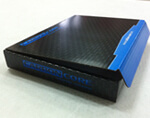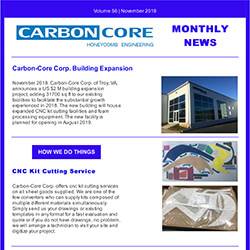The construction industry’s expectations are met with CarbonCore Plastic Honeycomb and CarbonFoam materials.
These expectations include:
- Rigidity and light weight enabling large dimensioned sections to be designed and used
- Easy handling
- Easy shaping enables modern designs
- Increasingly stringent sound and thermal insulation requirements
Applications:
- Large roofing areas
- Outer or technical doors for specific purposes
- Concrete forms
- Suspended platforms
Working With CarbonCore Plastic Honeycomb
1 – CUTTING and MACHINING
2 – FORMING
3 – WORKING UP
4 – FINISHING of the SANDWICH PANEL
Please click here for information about working with laminated veneer panels
CarbonCore Plastic Honeycomb is a polypropylene honeycomb covered on both faces with a soft polyester non-woven fabric. It is available in 2134 x 1219 (4′ x 7′) ready for direct use: lamination or gluing. Other sizes such as 4′ x 8′ are available upon inquiry. The flexible and light sheets enable an easy use in sandwich panels where most usual techniques of cutting, laminating and gluing can be applied. Since it is a thermoplastic product, other additional specific properties make its use even easier.
1 – CUTTING and MACHINING
1.1 – CUTTING
CarbonCore Plastic Honecyomb is cut by conventional means: saws, knives or a hot wire OS it is thermoplastic.
- Saws- In order not to burst or melt CarbonCore Plastic Honeycomb when cutting, the best tooth spacing is close to: 10 teeth per inch. Circular saws are particularly suitable for straight parts. 1/2 to 1″ wide band saws are suitable for straight cuts, 3/8″ for curved cuts.
- Knives – Cutting with a knife is possible. A “hawk bill” or “Linoleum” knife is quite suitable.
- Hot wire – Cutting can be carried out with an approx. 2mm tensioned wire heated at about 350°Cs (662’F).
1.2 – MACHINING
- At cold temperature – Classical tools for wood (ripper, grinder…) can be used by adapting the number of cutting blades and possibly the speed (too few blades can burst CarbonCore Plastic Honecycomb; too many can melt it),
- At hot temperature – Another way is to use the thermoplastic property: softening under heat.
1) CarbonCore Plastic Honeycomb polypropylene cells melt at 160°C (320.0″F) whereas the non-woven polyester, which covers the facings, melts at 240°C (464°F). Hence if CarbonCore is heated at about 200°C (392°F), (it melts locally to the shape required (hot stamping) without damaging the non-woven facing.
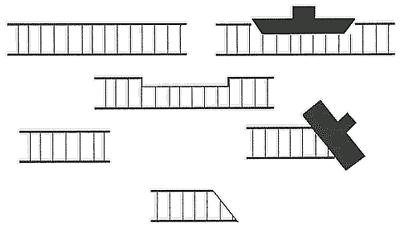
2) A second way is to cut the required shape and then to re-weld the nor polyester. For example, the following edges can be achieved:
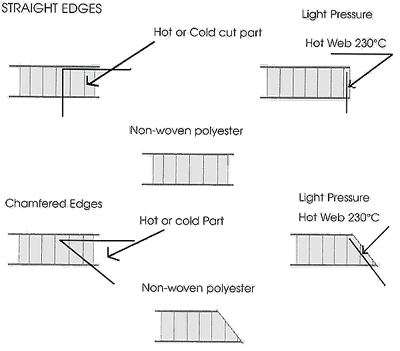
2 – FORMING
2.1 – COLD FORMING
The soft polyester non-woven scrim, which covers the large faces of CarbonCore Plastic Honecyomb makes it formable by:
- In the case of standard panels (3 psi to 12 psi) should be applied during curing time of polyester or glue. This can be done on a mold with vacuum or a matched die mold and a press.
- In the case of marine panels (scored 2″ x 2″ = 50mm x 50mm one side), a simple mold is sufficient.
2.2 – HOT FORMING and PRE-FORMING
Thermoplastic products are easily thermoformed:
- In a 3d mold in the oven, at less than 100°C (212°F), CarbonCore Plastic Honeycomb softens and under a very light pressure it very easily takes the required shape.
CarbonCore Plastic Honeycomb can also be hot preformed. Two possible processes:
- Preheating in an oven between 140°C (284°F) and 150°C (302°F), then forming in a cold mold.
- Forming in a mold heated at 130°C (266°F) -140°C (284°F).
In both cases CarbonCore will keep its shape at cold temperature.
In all cases, temperatures, pressures and timings should be setup according to the shape of the part and to the thickness of CarbonCore Plastic Honeycomb.
3 – WORKING UP
Sandwich panels with a CarbonCore Plastic Honeycomb core can be achieved either by direct laminations or by gluing a rigid skin.
3.1 – LAMINATION
The non-woven polyester applied on CarbonCore Plastic Honeycomb is an ideal surface for direct lamination of thermo hardening resins of polyester type (or other). However, considering their huge variety, resin formulations and lay up techniques should be checked against their compatibility with CarbonCore Plastic Honeycomb. Most traditional techniques (hand lay up, spraying, vacuum, pressing, low pressure injection), which are functions of existing tooling and depend upon the parts to be achieved, can be applied and need only slight adjustments to CarbonCore specificities.
Within the CarbonCore range, CarbonCore Plastic Honeycomb is especially suitable for lamination. CarbonCore Plastic Honeycomb has a plastic film under the face of the non-woven polyester which restricts resin passing through into the cells.
The operating principle of sandwich panels is to have a perfect adherence between the core and the rigid skins. Therefore when working up a panel, it is necessary to check:
- Good impregnation by resin to the core and skins.
- Good contact, e.g. through pressure, between the core and the skins.
Manufacturing process of a laminated sandwich panel with a CarbonCore Plastic Honeycomb core:
- Make the first skin of sandwich panel traditionally (gel coat on the mold, then required layers of glass-resin).
- Before the first skin has hardened, apply CarbonCore, interposing an extra ca 400-g/m.2 quantity of resin, either applied on the skin or on CarbonCore when hand lay up laminating. (If necessary, in the manufacturing process or in case of a thin laminate and if a very high quality surface finishing is required, it is possible to let the gel coat and one of several layers of glass-resin polymerize. As soon as polymerization is over, a last application of glass-resin is spread in order to glue CarbonCore as explained earlier. It is also possible to glue with shrink less polyester glue.)
- On CarbonCore, traditionally apply the required layers of glass-resin of the second skin, providing for an extra ca 400-g/m2 (1 1/2 fl. oz./ft.2) quantity of resin to impregnate CarbonCore and to ensure gluing with the laminate. Note: Pouring resin in heaps on CarbonCore without spreading it immediately should be avoided in order to prevent it from going through into the cells by gravity. As CarbonCore is a heater insulator, using a resin with too much exothermic should be avoided since it could damage the laminate or cause air bubbles. A glass mat should be preferred to a fabric for direct contact with CarbonCore Plastic Honeycomb.
- Once the part is achieved, it is advised to apply evenly distributed pressure on the whole (vacuum, press, and weight…) Hand lay up working is possible but a good CarbonCore laminate bonding (on the mould side) should be ensure by a former impregnation of CarbonCore then by a hand pressure on CarbonCore when fitting it. It is the same on lamination by simultaneous glass-resin spraying. Bonding of the other side is easier to check, as it is visible: additionally it is naturally made on the pressure unbubbling of the glass-resin layers.
- Two methods may be used for bedding scored CarbonCore Plastic Honeycomb. The first method uses either Chopped Strand Mat (CSM) or chopped fiberglass from a chopper gun and the second uses a core bonding putty such as CarbonBond CBC or a sprayable compound.
Additional considerations
- Assuming the gel coat, skin coat and any additional structural laminates of the outer skin have polymerized and returned to ambient temperature you may proceed to core bedding. To achieve a good chemical bond this should be started as soon as this “green” cure stage is reached. The fiberglass will have a “surface tack” indicating that it is still chemically active and subsequent laminates will adhere well. Also, please note that the scored core flexes freely in both axis’s so that it will conform to the tool.
- To properly bed the core, there should be no projections from the laminate surface that might create an air pocket underneath core. These may be sanded or ground off and any dust, particles or loose fibers removed.
- The surface should be wet out and a layer of 1.5 or 2oz CSM or the equivalent in chopped strand from a chopper gun. This bedding layer should be thoroughly saturated with catalyzed resin and rolled out to eliminate air bubbles.
- The core may be bedded scored side up or down depending on whether the mold is convex or concave. Just prior to bedding the core, a small amount of resin should be sprayed or rolled onto the side of the core to be bedded. This will prevent the scrim from potentially leaching resin from the chopped fiberglass bedding layer.
- Press the lightly wetted core firmly into the chopped strand layer. If the core does not stay fast to the contour, perhaps a few relief cuts will have to be made along the scoring lines. When all the core is observed to be firmly bedded, allow the bedding layer to polymerize without disturbing until it has returned to ambient temperature before proceeding to the next laminate. This is to prevent out-gassing or extreme exotherm from creating bubbles or blisters in the subsequent laminates.
- The process for trowelable or sprayable core bonding is identical with only the replacement of chopped strand fiberglass with a filled and thixotroped resin to adhere the core. As with the chopped strand bedding, a little extra resin must be applied to the bedding side of the core to prevent the scrim from leaching resin from the compound and potentially creating a resin starved interface. Instructions for use of CarbonBond CBC may be found in our website or in our catalog/handbook.
RTM techniques are possible with some products of the CarbonCore range. It depends on the technique used, injection pressure, temperature, and fluidity; therefore it is preferable to consult us in order to decide together upon a suitable product.
3.2 – GLUING
Non-woven polyester is used as a gluing surface to a lot of rigid skins such as wood, melamine laminates, marble, fibro-cement or metal.
Glue choice depends upon the skin to be glued and on the physical and the mechanical strains applied to the finished sandwich panel. Numerous glues were already satisfactory tested on CarbonCore: polyurethane, epoxy, neoprene, vinyl, polyester, and ureaformaldehyde.
When using a glue, test to ensure the compatibility of the different materials and the mechanical properties of the sandwich panel. Polyurethane or epoxy bicomponent glues are the most often used due to their good mechanical characteristics and their adherence on most materials.
Gluing process of sandwich panel with a CarbonCore core:
- According to the manufacture’s directions, evenly apply the required quantity of glue on the rigid skin or on CarbonCore or both at the same time, if so required by the glue. For polyurethane glue the quantity should be around 400 g/m2- (11/2 fl.oz/ft)
- In the same way, apply glue on the second skin or on the face of CarbonCore.
- Apply the pressure, specified by the glue, on the panel. A minimum of 0,2 bar and maximum of 1 (15 psi 29 In Hg,) bar is enough with regard to CarbonCore.
- Let the glue set under the indicated conditions before handling or applying efforts on the panel.
Characteristics of the sandwich panels are based mainly on the good adherence between the core and the skins, therefore special care should be taken when gluing and the results should be well checked. Note: Cells may show through the glued skin if the latter is too thin or not rigid enough. Print through is made worse by an excessive gluing pressure and/or the glue shrinkage when drying.
3.3 – WORKING UP PREPREGS
The high melting temperature of polypropylene makes it possible to use prepregs, which polymerize at temperatures up to 125°C (at 100°C [212°F] CarbonCore still resist to 1 daN/cm compression).
Position the prepreg on CarbonCore, apply pressure at the required temperature and let the whole polymerize. According to the temperature and to the polymerization time, check that there is no risk of collapse of CarbonCore due to the flow. Under a press, a possible solution consists in positioning shims very slightly less thick than CarbonCore in order to avoid this flow.
Unmolding should not be carried out too hot to avoid any risk of distorting the panel or of de-laminating CarbonCore.
4 – FINISHING of the SANDWICH PANEL
4.1.1 – LAMINATED PANELS
Several types of finishes are possible for laminated panels. Molding of polyester skins makes it easier to work out edges, as shown in the following examples:
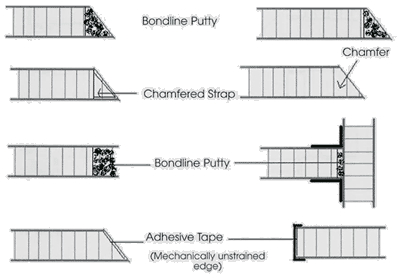
Most frequently, edge finishing is carried out through a frame or a finishing profile. It’s material will be chosen according to the physico-chemical strains of manufacture and use. Wood is interesting by it’s very wide flexibility of use but it may require trimming and is sensitive to moisture. Plastic or metal enable a direct finishing but need a very exact size.
Setting the frames or profiles can be carried out, as shown by the following examples, either before or after the panel is made:
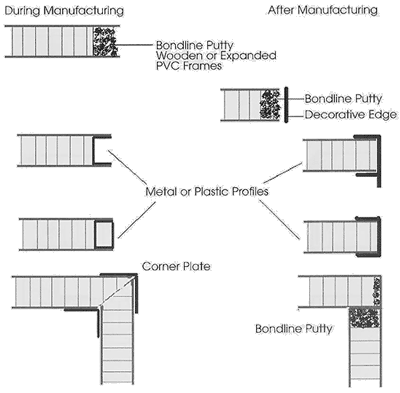
4.1.3 – GLUED PANELS
Several types of finishings are possible according to the skins, the panel use and the mechanical strains applied.
Unstrained decorative edges can be merely glued an both rigid skins. In case of a metal sheet, a mere fold can hide the edge.
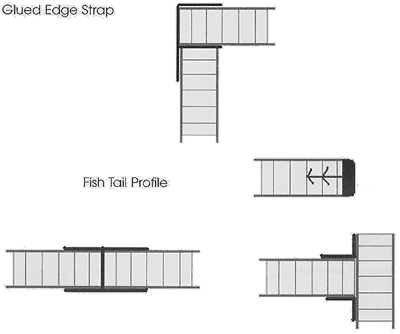
4.2 – LOCAL STRENGTHENING PARTS, FIXING INSERTS for ELEMENTS OR OBJECTS
Fixing elements on a sandwich panel may require local strengthening parts or inserts. Choosing the adequate solution essentially depends on the strains transmitted by fixing to the skins or to the core. Fixings can be tranversing or not.
4.2.1 – NON TRANVERSING FIXINGS
4.2.1.1 – LIGHT LOADS
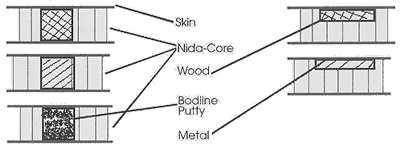 Considering the good cohesion of CarbonCore and the good adherence of skins if they were bonded up properly, fastening can be carried out in a normal way: rivets, bolts and, self tapping screws, on only one skin (Fig. 1).
Considering the good cohesion of CarbonCore and the good adherence of skins if they were bonded up properly, fastening can be carried out in a normal way: rivets, bolts and, self tapping screws, on only one skin (Fig. 1).
If the load makes it necessary or if the skin is insufficiently strong, a glued metallic strengthening part can be added and will distribute the stress.
4.2.1.2 – HEAVY CONCENTRATED LOADS
In case of non-though fastenings, the most frequent solution consists of, before gluing the skins of the sandwich panel, in placing inserts which locally build up a solid panel into which fastening is carried out in a classical way.
The most frequently used insert is wood, but metal or resin inserts are also suitable. The insert can occupy the full or only part of the thickness of the panel. For greater flexibility of use, it is also possible to make resin inserts on finished panels.
Considering the fixings to be made, inserts can be large or small:
- Large inserts – The upper skin is removed from the surface concerned by the insert. Mastic resin is applied with a spatula into the cells of CarbonCore. Once the resin is dry, sanding leaves a clean and surface on which solid fixing is possible.
- Small inserts – The upper skin is perforated at the spot planned for the insert. Using a cutting tool, a few cells sheared around the hole then filled up with resin. Fasteners can be inserted into the resin.
4.2.2 – THROUGH FASTENINGS
Through fastening can be carried out:
- with inserts as described above
- with a metal or pultruded plastic compression sleeve
- with specially adapted fasteners.
4.3 – THERMOWELDED INSERTS
Because of its polypropylene composition, CarbonCore can very easily receive polypropylene inserts by friction welding.
The 15mm thick insert, whose diameter can vary according to the resistance wished, is positioned on CarbonCore at required spot.
Using a rotating tool at 1500 revolutions a minute, light pressure is applied on the insert.
Rotation and pressure create the heating, which enables perfect welding between the insert and CarbonCore.
The panel thus prepared can receive the final skins. On the insert, solid fixing is carried out with specially adapted screws.

